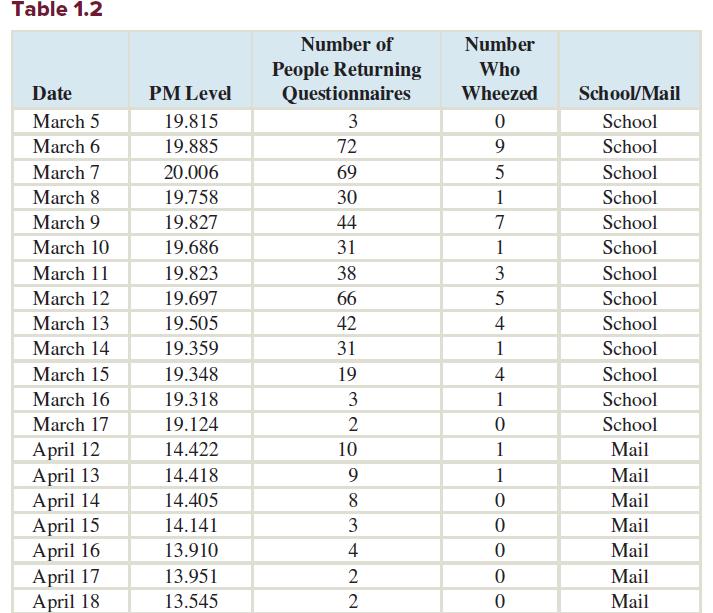Air pollution is a serious problem in many places. One form of air pollution that is suspected
Question:
Air pollution is a serious problem in many places. One form of air pollution that is suspected to cause respiratory illness is particulate matter (PM), which consists of tiny particles in the air. Particulate matter can come from many sources, most commonly ash from burning, but also from other sources such as tiny particles of rubber that wear off of automobile and truck tires.
The town of Libby, Montana, was recently the focus of a study on the effect of PM on the respiratory health of children.
Many houses in Libby are heated by wood stoves, which produce a lot of particulate pollution. The level of PM is greatest in the winter when more stoves are being used, and declines as the weather becomes warmer. The study attempted to determine whether higher levels of PM affect the respiratory health of children. In one part of the study, schoolchildren were given a questionnaire to bring home to their parents. Among other things, the questionnaire asked whether the child had experienced symptoms of wheezing during the past 60 days. Most parents returned the questionnaire within a couple of weeks. Parents who did not respond promptly were sent another copy of the questionnaire through the mail. Many of these parents responded to this mailed version.
Table 1.2 presents, for each day, the number of questionnaires that were returned by parents of children who wheezed, the number returned by those who did not wheeze, the average concentration of particulate matter in the atmosphere during the past 60 days (in units of micrograms per cubic meter), and whether the questionnaires were delivered in school or through the mail.
We will consider a PM level of 17 or more to be high exposure, and a PM level of less than 17 to be low exposure.
1. How many people had high exposure to PM?
2. How many of the high-exposure people had wheeze symptoms?
3. What percentage of the high-exposure people had wheeze symptoms?
4. How many people had low exposure to PM?
5. How many of the low-exposure people had wheeze symptoms?
6. What percentage of the low-exposure people had wheeze symptoms?
![]()
7. Is there a large difference between the percentage of high-exposure people with wheeze symptoms and the percentage of low-exposure people with wheeze symptoms?
8. Explain why the percentage of high-exposure people with wheeze symptoms is the same as the percentage of school-return people with wheeze symptoms.
9. Explain why the percentage of low-exposure people with wheeze symptoms is the same as the percentage of mail-return people with wheeze symptoms.
10. As the weather gets warmer, PM goes down because wood stoves are used less. Explain how this causes the mode of response (school or mail) to be related to PM.
11. It is generally the case in epidemiologic studies that people who have symptoms are often eager to participate, while those who are unaffected are less interested. Explain how this may cause the mode of response (school or mail) to be related to the outcome.
12. Rather than send out questionnaires, the investigators could have telephoned a random sample of people over a period of days. Explain how this might have reduced the confounding.
Step by Step Answer:






